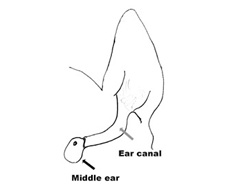
Otitis externa is an inflammation of the ear canal. Because dogs’ ear canals are L-shaped (Figure 1), fluid does not drain easily from canal openings. Additionally, the lining of the ear can become inflamed and thickened, blocking air and fluid flow in and out of the canal. Animals with otitis externa can also develop otitis media (middle ear inflammation). Similar to the problem seen in children (especially after airplane flights), fluid can build up behind the ear drum, causing pressure and pain. Otitis externa and media are common conditions in dogs, particularly in specific breeds such as the Cocker spaniel and German shepherd.
In puppies and kittens, otitis externa is often caused by ear mites. These tiny parasites cause terrible itching and a thick brown discharge. In adult dogs, the most common underlying cause is allergies- sensitivity to something in the environment or to food. In older animals, tumors can cause blockage of the ear canal and secondary infection. Other predisposing causes may include foreign bodies (such as grass seeds), or small ear canals (often seen in Shar peis) or long floppy ear flaps (for example, Basset hounds) that prevent air flow. Hormonal problems, such as poor thyroid function, or other underlying skin disorders may also be present.

Dogs with otitis externa may start out with mild signs, but can progress with time or failed treatment attempts such as:
- scratching their ears or shaking their heads
- ears may be thick or red on the underside or hairless part
- ears may have a strong, unpleasant smell
- ear canal will eventually be blocked and have a cauliflower-like appearance (Figure 2)
- white thick discharge from the ears of dogs if bacterial infections are present
Because the condition is painful, particularly when the middle ear is affected, pets may have personality and behavioral changes. They may shy away from being petted on the head, and may be uncomfortable opening their mouth wide or chewing food. Additionally, blockage of the ear canal muffles their hearing and makes them less responsive to their owners.

Unless a tumor, foreign body, or ear canal narrowing or blockage is present, otitis externa is usually treated medically. First, however, your primary care veterinarian must determine the underlying cause of the ear disease. They may perform:
- Otoscopic exam to look down into the ear canal with a lighted scope, to see if there is anything unusual in the canal and will take samples from the ear to determine whether your dog has problems with yeast, bacteria, or mites.
- Culture of discharge in the ears to determine which bacteria might be present and what antibiotics to which they might be sensitive
- X-rays or a CT scan to evaluate the ear canal and determine if the middle ear is involved (Figure 3). If the ear canal cartilage is no longer bendable and has become calcified, surgery will probably be required.
- Blood test: thyroid gland function and blood chemistries to see if there is any signs of systemic illness
- Allergy testing or skin scrapes to asses allergies
Medical management is preferred in pets that have inflammation and discharge of the ear canals, but no blockage. The ear canals are cleaned and flushed, and your veterinarian may even need to drain the middle ear to relieve the fluid buildup. Pets are treated with a medication that kills mites, bacteria, or yeast, depending on what type of organism is found in the canal. Because pets with ear infections are uncomfortable, pain medications may be prescribed. Animals with allergies may require shots or a diet change.
Pets that have a tumor, traumatic separation, calcification, or other blockage of the canal may require removal of the ear canal. This surgery is very complicated and should only be performed by an ACVS board-certified veterinary surgeon.
Surgical Options:
- Total Ear Canal Ablation and Bulla Osteotomy
When the ear canal is completely calcified or blocked by thickened lining or a tumor, the entire ear canal may need to be removed (Figures 4). The ear flap is left in place, but may droop a little in dogs with upright ears, such as shepherds. The veterinary surgeon will also need to open the middle ear, or bulla, to remove the lining and provide drainage. Because dogs with otitis externa and media have very thickened and inflamed ear canals, the surgery may be long and complex and the animal will require pain medication for several days after recovery. - Vertical Ear Canal Ablation
Occasionally, the horizontal portion of the ear canal is normal and only the upright, or vertical portion, needs to be removed. This procedure is less complicated than total ear canal removal and does not require opening and cleaning out the middle ear. Although the veterinary surgeon may plan to perform a vertical ear canal ablation, they may find during the surgery that the entire ear canal must be removed because of the extent of the ear canal disease. - Lateral Ear Canal Resection (“Zepp”) Procedure
Opening up the side of the ear canal will let more air in, improve drainage, and make it easier for owners to clean and medicate the canals (Figures 5 and 6). Unfortunately most dogs do not show much improvement after this procedure, so it is usually reserved for dogs that are born with narrow ear canals.
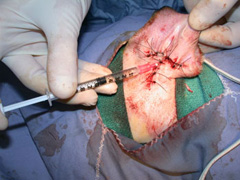
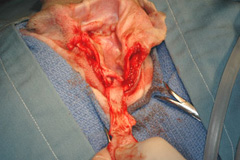
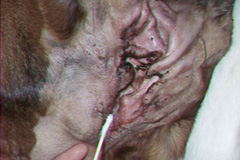
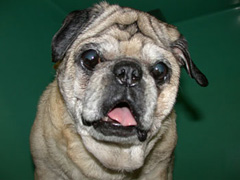
Most pets will go home in 3–7 days depending on their comfort.
Restrictions following surgery are usually:
- an E-collar to prevent scratching the ear incision
- eye drops for two weeks if the blink response is not normal
- oral pain medications
- antibiotics may be prescribed if severe infection is present
- sutures will be removed 10–14 days after surgery (if present)
- medical management of underlying diseases, such as allergies or poor thyroid function, will need to be continued for life to prevent clinical signs from recurring
Postoperative complications can include:
- Facial nerve damage; resulting in an abnormal or absent blink in the eye on the side of the surgery. This occurs in 25–50% of dogs, and in 10–15% the damage is permanent
- Head tilt (Figure 7), because of the loss of balance
- Drainage from the surgical site months to years after surgery may occur if some infection or secretory tissues remain after the original surgery
Since most pets with severe otitis externa have poor hearing before surgeries, owners often do not notice much difference in their dog’s hearing ability after surgery.
Owners of certain breeds of dogs, such as Cocker spaniels, should be prepared for ear problems. These dogs should have their ears checked once or twice a year, and any ear infections should be treated promptly to prevent inflammation and thickening of the canal. Any dogs prone to skin or food allergies should also be checked annually.
Prognosis for surgical treatment of otitis externa and media depends on the underlying cause of the disease. Total ear canal ablation with bulla osteotomy is successful in resolving the drainage and discomfort from the ear in 90–95% of dogs, but problems can recur if underlying allergies or disease are not controlled. Long term success rates are much poorer when lateral ear canal resections are performed on animals that have severely diseased ear canals.












